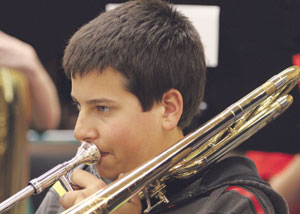
We’ve got to put a stop to the arm(s) race. Trombonists everywhere flick and jerk the slide faster and faster to avoid the dreaded glissando and thereby obliterate the legato as we (and everyone else) know it. We have to stop apologizing for the fact that we can play smoother than any other instrument. My rule for legato is this: produce as much sound between the notes as possible without a smear. Trombonists around the world have an amazing array of techniques to avoid playing a true legato. They go around it, jump over it, go under it, but rarely go through it. Of course I don’t like a sloppy slide either, but I also don’t advocate abandoning it.
In my experience 95%+ of people I hear have a legato that is too hard. Less than 5% have a legato that is too smeary. What that tells me is that if 100% of players had a legato that was too hard, the trombone is incapable of anything but a hard legato, but those 5% prove that somewhere between the extremes lurks the most beautiful legato slur in the world. What would that sound like? I try to tailor my legato slur to the sound of male voices singing a Gregorian chant, because to me that is the most beautiful legato sound. I haven’t gotten there yet, but I’m still trying.
Trombone players face a challenge in legato playing because of the things we have to do to achieve a consistently smooth legato. Every slur requires a different combination of legato tongue and slide movement. The expedient way is to use one quick jerk of the slide and eliminate legato completely. You have then joined the slide-flickers club. This club entitles you to never concern yourself with legato again and to not worry about the supposed curse of every trombone player; the portamento. A lightning fast slide arm will probably be somewhat rigid, so you won’t have to worry about sustaining the big fat resonant sound that comes with a relaxed slide arm and velvet smooth legato. You’ll further reduce the burden of a big sound by eliminating all sound between notes and be in the mainstream of current trombone pedagogy. My question is if you are sure this is what you want.
Here are my ideas on playing and teaching legato:
I never move the slide without the air moving with (or preferably ahead) of it. The slide moves through the notes rather than from one to the next. Even though the slide stops in each position, imagine that it doesn’t. The air stream is continuous on and between notes. On a slur that crosses a partial, try to get as much sound as possible before that partial so it resembles a long legato slur. Imagine a rubber band (the air) that is pulled along with the slide to another position. The slide should move smoothly and silently so as not to disturb the air stream whatsoever, and not vice-versa. Avoid a slide show performance.
This begs the question of how fast or slow you should move the slide. The answer is to move it at whatever speed it takes to get the smoothest, most beautiful slur you can imagine. At whatever speed you move, move it smoooothly. Push the legato as far as you need to find out where the line between legato and glissando is. When you have crossed the line between legato and glissando, don’t run in the other direction to where the crowd has retreated. Greatness requires risk taking.
As I visualize what a great legato looks like, it is something like this: imagine a few bowling balls (the notes), and they are inside a large tube, similar to the vents of a drier. It looks like a slinky coated in plastic to make it smooth. The amount of space between the bowling balls is adjustable to match the type of slur you want, but the bowling balls never touch each other and the tube has the same circumference as the bowling balls. I sometimes think of the slide as a tire on a car, and I try to keep the tire pressure at a steady 32 psi while moving the slide.
In order to play the same great slur in various registers, think of the solo in Bolero. The end of the solo requires more legato tongue and a faster slide movement than the first half of the solo. The rule is that the closer the partials (in the higher register) the more time I allot (less tongue) between notes. At first you will have to think about every slur and adjust accordingly, but in time you will think musically and match the perfect slur in your head. Before long it will happen automatically. The big challenge is to control your slide arm, which tends to go to the flick mode, as if on auto pilot. Imagine the world’s most beautiful slur and have your brain tell your body, “Do whatever you have to get that slur on every note.”
Remember, your arm is part of your body and must be as relaxed as the rest of your body. Move the slide as if it was the least important thing in making a sound, because it is. The slide is like a conductor, it can flail away, but without any players (air) it makes no sound and is for nothing. I try to feel that I am blowing the slide from position to position. My arm follows the air stream passively. I rarely get a blank because my air is usually waiting for the slide to arrive instead of the other way around. If I want to slur from middle Bb to Eb above the staff, I start bending my air up even before I move the slide. Then it will feel that I am pulling the slide to 3rd with the air. I won’t get any other notes in between because I went up and over that break with the air rather than from underneath, which would have been the result of the slide getting before the air. A good exercise to try this is to gliss from middle Bb down to Ab and then slur to Bb. Now take that air you used for the gliss and send it up to the Eb. Make sure the slide moves with or behind the air. It should have the same feel that it had to the Ab. This concept will work on every other slur as well. It works great on something like Schumann’s Rhenish excerpt.
You will know you have a great legato when no one can tell exactly when a note changed because one note flows into another without any break in the continuity of sound. At this point a composer such as Wagner, with his beautiful legato writing for trombone, can rest easy once and for all.





